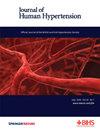撒哈拉以南非洲的高血压:现状、最新进展、差距和优先事项
IF 2.7
4区 医学
Q2 PERIPHERAL VASCULAR DISEASE
引用次数: 0
摘要
最近的全球和地区报告一致证实,撒哈拉以南非洲地区(SSA)的高血压发病率很高,而且还在不断上升,但发现率、治疗率和控制率却很低。这篇叙述性综述总结了撒哈拉以南非洲地区的高血压负担以及基于社区的高血压管理策略的最新发现。根据最新数据,我们进一步概述了突出的风险因素以及高血压发病的相关内在机制。对文献的广泛综述显示,尽管由于缺乏具有全国代表性的研究、抽样和数据收集方法的异质性而存在局限性,但大多数国家都报告了 2017-2023 年期间的高血压患病率。据报告,向示范患者和社区卫生工作者分配角色的任务转移方法改善了与医疗保健服务的联系和坚持服药的情况,但随着时间的推移,关于降低血压(BP)效果的研究结果并不一致。定期报告的风险因素包括不健康饮食、久坐不动的生活方式、脂肪增加和体重不足、年龄增长、教育水平和/或收入以及社会心理因素。有关导致高血压的病理生理机制和潜在干预领域的最新数据来自儿童和成人,其中包括盐处理和容量超载、内皮功能、血压下降模式和人类免疫缺陷病毒的作用等。总之,撒哈拉以南非洲地区在报告该地区高血压负担的数据以及生物标志物研究方面取得了长足进步,从而加深了对干预领域的了解并确定了干预领域。然而,在知识生成、转化和实施研究之间的联系方面仍存在差距。针对发现科学和公共卫生的协调研究对于遏制 SSA 地区高血压的发展和改善管理至关重要。本文章由计算机程序翻译,如有差异,请以英文原文为准。


Hypertension in sub-Saharan Africa: the current profile, recent advances, gaps, and priorities
Recent global and regional reports consistently confirm the high and increasing prevalence of hypertension in sub-Saharan Africa (SSA), with poor detection, treatment, and control rates. This narrative review summarises the burden of hypertension in SSA and recent findings from community-based hypertension management strategies. We further outline prominent risk factors according to recent data and associated underlying mechanisms for hypertension development. An extensive review of literature showed that most countries have reported on the prevalence of hypertension during 2017–2023, despite limitations linked to the lack of nationally representative studies, heterogeneity of sampling and data collection methods. Task-shifting approaches that assign roles to model patients and community health workers reported improved linkage to healthcare services and adherence to medication, with inconsistent findings on blood pressure (BP)-lowering effects over time. The regularly reported risk factors include unhealthy diet, sedentary lifestyle, increased adiposity and underweight, ageing, level of education, and/or income as well as psychosocial factors. Newer data on the pathophysiological mechanisms leading to hypertension and potential areas of intervention are reported from children and adults and include, among others, salt-handling and volume overload, endothelial function, BP dipping patterns and the role of human immunodeficiency virus . To conclude, significant strides have been made in data reporting from SSA on the burden of hypertension in the region as well as biomarker research to improve understanding and identification of areas of intervention. However, gaps remain on linkage between knowledge generation, translation, and implementation research. Coordinated studies addressing both discovery science and public health are crucial to curb hypertension development and improve management in SSA.
求助全文
通过发布文献求助,成功后即可免费获取论文全文。
去求助
来源期刊

Journal of Human Hypertension
医学-外周血管病
CiteScore
5.20
自引率
3.70%
发文量
126
审稿时长
6-12 weeks
期刊介绍:
Journal of Human Hypertension is published monthly and is of interest to health care professionals who deal with hypertension (specialists, internists, primary care physicians) and public health workers. We believe that our patients benefit from robust scientific data that are based on well conducted clinical trials. We also believe that basic sciences are the foundations on which we build our knowledge of clinical conditions and their management. Towards this end, although we are primarily a clinical based journal, we also welcome suitable basic sciences studies that promote our understanding of human hypertension.
The journal aims to perform the dual role of increasing knowledge in the field of high blood pressure as well as improving the standard of care of patients. The editors will consider for publication all suitable papers dealing directly or indirectly with clinical aspects of hypertension, including but not limited to epidemiology, pathophysiology, therapeutics and basic sciences involving human subjects or tissues. We also consider papers from all specialties such as ophthalmology, cardiology, nephrology, obstetrics and stroke medicine that deal with the various aspects of hypertension and its complications.
 求助内容:
求助内容: 应助结果提醒方式:
应助结果提醒方式:


